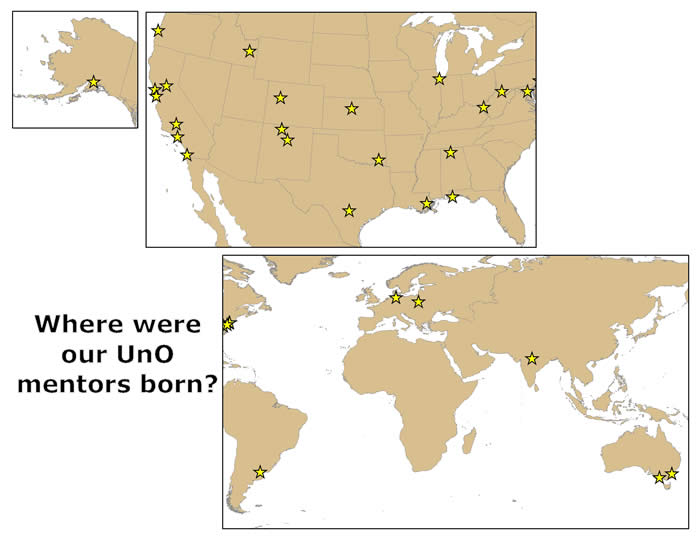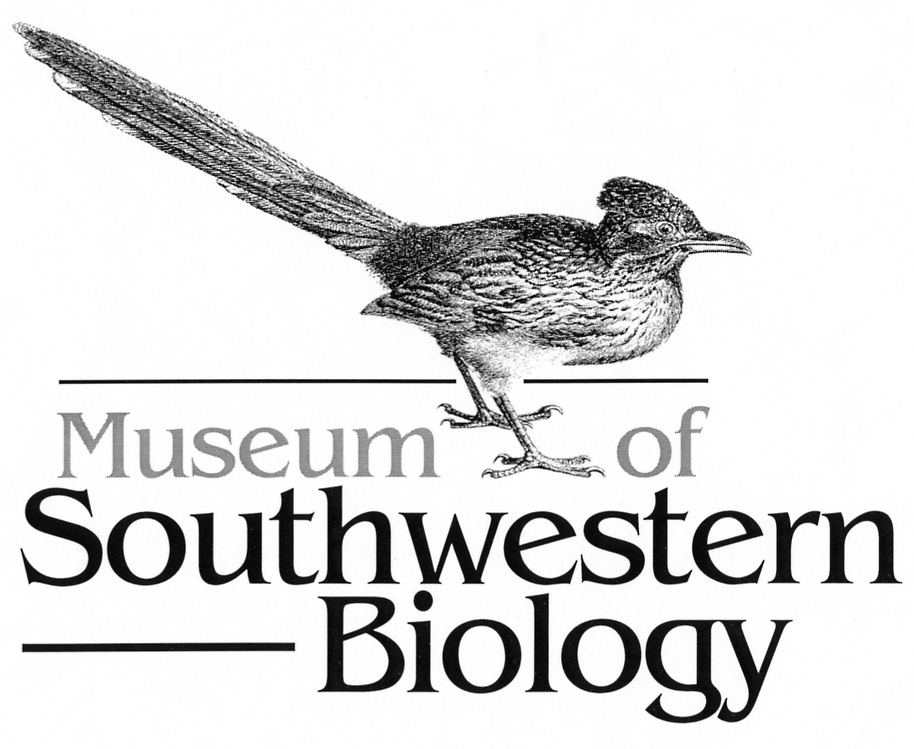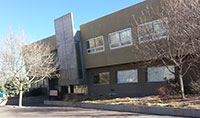UnO Mentors
Faculty Mentors
Joseph Cook, PI: Professor of Biology, Curator of Mammals. Research: molecular ecology, conservation genetics, and evolution of mammals and associated parasites.
William Gannon, Co-PI: Research Assistant Professor, Biology; Senior Scientist, Museum of Southwestern Biology; Assistant Director, UNM Office of Research & Compliance. Research: small mammal ecology and behavior
Becky Bixby: Research Assistant Prof., Biology. Research: periphyton ecology and biodiversity.
Sara Brant: Research Assistant Prof., Biology. Research: molecular variation of parasites of birds and mammals and associations with their hosts.
James Brown: Distinguished Professor. Research: Community ecology and biogeography, with special projects on granivory in desert ecosystems; biogeography of insular habitats; and structure of dynamics of geographic-scale assemblages of many species.
Scott Collins: Professor of Biology, PI/Director of Sevilleta Long-Term Ecological Research Program. Research: the role of climate variability, fire and herbivores on community structure and ecosystem processes in mesic and arid grassland.
Ben Hanelt: Research Assistant Professor at UNM. Research: The interface between evolution, ecology, genetics, and genomics of parasitic organisms and their hosts.
Vaishali Katju: Assistant Professor. Research: Comparative evolutionary genomics; deleterious and compensatory mutations; evolution of eukaryotic genomes; evolution of reproductive incompatibility; experimental evolution; gene duplication and the origin of novel genes.
Astrid Kodric-Brown: Professor of Biology. Research: Behavioral ecology of freshwater fishes, especially the evolution of mate recognition systems and their role in speciation in pupfishes (Cyprinodon). Allometry of sexually-selected traits. Community structure and conservation of desert fishes.
Tim Lowrey: Professor of Biology, Curator of Herbarium, Museum of Southwestern Biology. Research: reproductive biology and evolutionary systematics of arid land vascular plants.
Diane Marshall: Professor of Biology. Plant reproductive ecology; the importance and mechanisms of secual selection in plants; plant mating systems; placticity, especially in reproductive characters.
Kelly Miller: Assistant Professor of Biology. Research: systematics of insects and other arthropods, species level to higher phylogenetics with morphology and DNA sequences data.
Diana Northup: Visiting Associate Professor, Biology, and Professor Emerita, Centennial Science & Engineering Library. Research: Microbiologist interested in cave microbial ecology using molecular and microscopy techniques.
Steven Poe: Associate Professor. Research: theory and practice of phylogenetic systematics; Anolis lizard biology; herpetology, especially lizards and crocodilians; evolution of development; philosophy of biology.
Ursula Shepherd: Associate Professor of University Honors, Research Assistant Professor of Biology. Research: ecological field research techniques; PI, NSF “Biodiversity of Australia.” Congradulations U.S. Professor of the Year!
Howard Snell: Professor and Curator, Division of Amphibians and Reptiles, The Museum of Southwestern Biology. Research: Conservation biology of the Galapagos islands, evolutionary ecology, and herpetology.
Felisa Smith: Associate Professor of Biology. Research: bridging gap between ecology and paleoecology.
Cristina D. Takacs-Vesbach: Assistant Professor. Research: Molecular microbial ecology, especially microbial diversity and productivity in extreme environments.
Randy Thornhill: Distinguished Professor. Research: Evolution and ecology of social interactions, especially sexual interactions and sexual selection.
Thomas Turner: Associate Professor of Biology, Curator of Fishes, Museum of Southwestern Biology. Research: basic/applied questions in evolution/ecology of aquatic species & communities.
Helen Wearing: Assistant Professor. Research: Theoretical biology and disease ecology; using mathematical and statistical approaches to understand the biological processes that shape population and community dynamics, with an emphasis on host-parasite interactions.
Christopher Witt: Assistant Professor of Biology. Research: physiology & hemoglobin evolution in high-altitude hummingbirds.
Blair Wolf: Associate Professor of Biology. Research: physiological ecology, ecology of desert animals, plant–animal interactions, animal energetics and water balance. Avian biology, particularly reproductive biology and habitat selection.
Staff and Graduate Student Mentors
| Chuck Hayes, Blair Wolf Lab: Chuck is a Ph.D. student in the Wolf lab. His research compares the assimilation of seasonal energy resources and population growth between Gunnison ’s prairie dog colonies in prairie and montane environments. He has spent the past 15 years as a wildlife biologist with the New Mexico Department of Game and Fish, working in carnivore management, endangered species, wildlife information systems, and conservation grant programs. Chuck has followed his desert beginnings, growing up in Lordsburg, NM, through a variety of biologist jobs in the southwestern U.S. working on bighorn sheep, loggerhead shrikes, and Sonoran pronghorn before settling in the Albuquerque area with his wife, Shannon (UNM Biology’s program coordinator for undergraduate advising). |
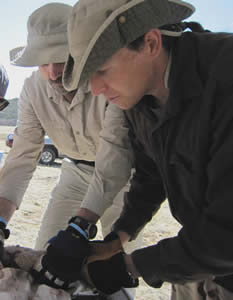
Chuck & Kevin |
| Trevor Fristoe, James Brown Lab: While Trevor's interests within the field of ecology are varied and span a wide range of taxa, his dissertation work at the University of New Mexico has focused on understanding the biogeography and community dynamics of migratory birds. Using the metabolic theory of ecology and the perspective of migrants as consumers within their communities, he hopes to understand the role that migratory species play in the communities where they breed and overwinter and how it determines their ranges throughout the year. To accomplish this, he employs a macroecological approach and conducts field work at study sites in the taiga and tundra of his home state of Alaska. |
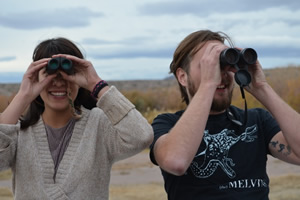
Trevor & Adeline |
| Kina Murphy, Scott Collins Lab: Kina Murphy is interested in plant and large herbivore community interactions: This includes the movement and assemblage patterns, body size, scaling and energy exchange of large herbivores. Her research focuses on how the movement patterns and metabolic rates of large herbivores impact net primary productivity and carbon sequestration along the Chobe-Linyanti-Zambezi Wetland in Botswana, and comparatively on the Pritzlaff Ranch and Villas Caldera in New Mexico. Murphy has a Fulbright in ecology focusing on the movement and assemblage patterns of large herbivores along the Chobe-Linyanti-Zambezi wetland in Botswana; and a Master’s in Community and Regional Planning from UNM, focusing on wildlife management and human wildlife conflict mitigation along the Chobe-Linyanti-Zambezi Wetland. Her Undergraduate degree is in conservation science, and she has been a conservation professional since 2000 working in Southern Africa and the Southwestern US. Murphy is the president and founder of Global Conservation Assistance and the Former Conservation Director for Earthworks Institute. |
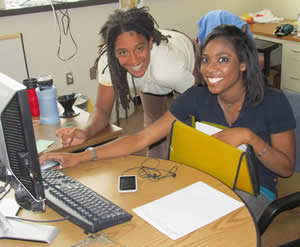
Kina & Andrea |
| Kayce Bell, Joe Cook Lab: Kayce's research is exploring the phylogeography of chipmunks and their common parasites. Chipmunks commonly have two species of sucking lice and two species of pinworms. Kayce's research aims to determine how these associations may have persisted or changed through time. After receiving her Ph.D., she plans to continue doing research on host-parasite interactions, ideally in association with a natural history collection at a university. |
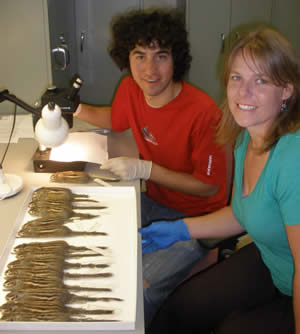
Kayce & Diego |
| Dr. Sylvia Brunner, Joe Cook Lab: Research Associate at UNM. Research: morphometrics of otariid seals. |
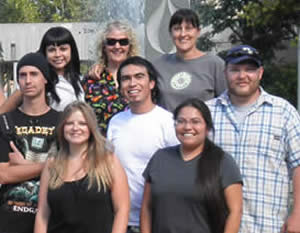
Sylvia (back) with several scholars |
| Dr. Jon Dunnum, Joe Cook Lab: Jon's research interests include Systematics, phylogeography and taxonomy of the Caviidae, Evolution of South American Caviomorphs, Integrated natural history collection archiving, and databasing of natural history collection data. |
|
| Dr. Chris Himes, Joe Cook Lab: Chris is an ASERT – IRACDA Postdoctoral Fellow in the Department of Biology at the University of New Mexico. He received his bachelor’s degree from University of Massachusetts in Boston, where he was a fellow in the Ronald McNair Program. Pursuing his interests in research and teaching, Chris entered the Department of Zoology at the University of Washington and earned his Ph.D. in 2008. As a graduate student, he worked at the Burke Museum studying the biogeography and evolution of mammalian populations in the temperate forests of North and South America. Chris recently was a HHMI Postdoctoral Fellow at Williams College where he tested the influence of isolation on island populations of chorus frogs from Isle Royale National Park in Lake Michigan. At UNM, Chris is examining the mechanisms impacting genome-wide patterns of diversity within species of the Tropical Andes Forest of South America, a hotspot for biodiveristy. Chris is co-advised by Dr. Joe Cook of UNM and Dr. Enrique Lessa of Universidad de la República, Uruguay. |
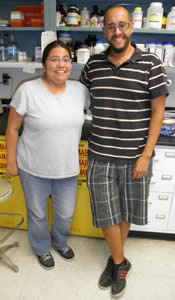
Chris & Hiyatsi |
| Brooks Kohli, Joe Cook Lab: Brooks' Master's thesis project will focus on the phylogeography of northern red-backed voles (Myodes rutilus), an holarctic species. The primary goal of the study is to gain an understanding of the genetic structure of the species in the context of historical and contemporary factors, such as glaciation and range expansion. Other interests he has in biology include ecology and conservation. |
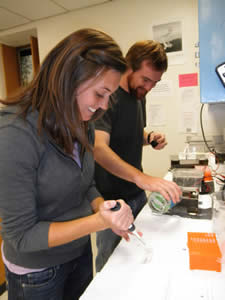
Brooks and Kelly
|
| Jason Malaney, Joe Cook Lab: Jason Malaney is a graduate student in the molecular lab of Joe Cook at the University of New Mexico Department of Biology and Museum of Southwestern Biology. He studies the genetic diversity in mammals across the landscape to understand how historical influences such as glaciations and climatic fluctuations influenced demographic histories. His current focus is assessing phylogeographic structure of multiple boreal species with a comparative perspective. The fundamental question is - do communities remain intact through time (Clementsian) or are contemporary communities assemblages of species responding to environmental change idiosyncratically (Gleasonian)? Specifically this project investigates molecular variation in several species of boreal mammals of the North American West. Inquiry of mitochondrial and nuclear DNA sequence variation have revealed a complex history of population expansion and colonization from multiple glacial refugia during the Holocene. Repeated spatial and temporal patterns of lineage divergence within species reflects the common signature of climate change on structuring genetic variation and may also indicate the long-term association and persistence of communities across dynamic geologic events. These investigations specifically address hypotheses related to the most recent glacial cycles and how genetic diversity (patterns) has been affected by changing climate (processes) resulting in incipient speciation. |
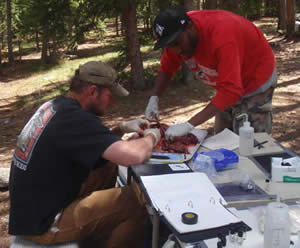
Jason and Randle |
| Jolene Rearic, Joe Cook Lab: Jolene’s research is focused on the evolution of freeze tolerance in frogs. She is looking at correlations between ecological niche and the emergence of this character, as well as evolution of proteins related to freeze tolerance in frogs. Her primary interests include complex trait evolution, selection on functional genes and conservation. |
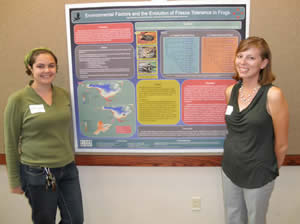
Jolene and Angie |
| Yadéeh Sawyer, Joe Cook Lab, UnO Program Coordinator: Yadéeh is Hispanic and her dissertation work is a comparative phylogeography of small mammals in Southeast Alaska. She is investigating both mitochondrial and nuclear markers to ases the effects of historical climate change on current genetic structure in this complex island system. Upon graduation she hopes to pursue a career in ecosystem management, connecting research and policy. |
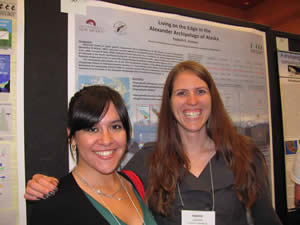
Yadéeh and April |
| Angela Hung, Astrid Kodric-Brown Lab |
|
| Riannon West, Astrid Kodric-Brown Lab: Rhiannon is a PhD student in Dr Astrid Kodric-Brown's lab. To address her primary interest in sexual selection and her general interests in behavioral ecology and evolutionary biology, her work spans female mate choice and life-history tactics in pupfish; sympatric speciation; olfactory sensing of immune system products; the evolution of brain size in birds; and the role of humor in human mating. Additionally, she is interested in how behavioral and evolutionary theory can be used to inform governmental policy. |
|
| Allison Chatterjee, Diane Marshall Lab |
|
| Heidi Hopkins, Kelly Miller Lab: Heidi is passionately interested in all aspects of cockroach systematics, behavior and evolution. Her dissertation will contain chapters on diverse aspects of this taxon, including a revision of at least one genus of Polyphagid roach (Arenivaga), a behavioral analysis of at least one species of Blaberid roach, and a Lucid key to the families of roaches. She is always at work on my dream of a field guide to the world's cockroaches. She plans to use her degree to conduct further research on cockroaches and teach biology at the college level. |
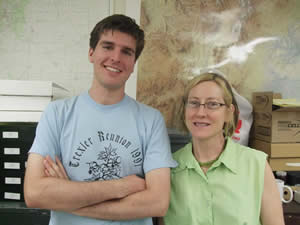
Heidi & Nick |
| Dr. Mike Spilde, Diana Northup Lab |
|
| Dr. Tom Giermakowski, Howard Snell Lab: Tom is an ecologist most interested in the distribution of amphibians and reptiles. For his dissertation he's worked with tortoises in Galápagos and used modeling to predict likely occurrence of amphibians and reptiles in New Mexico. He's currently working on likely changes in distribution of several southwestern reptiles due to climate change. |
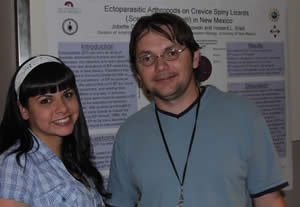
Tom & Joey |
| Kenneth Letendre, Randy Thornhill Lab: Kenneth studies group behaviors in social organisms. His dissertation work has focused on the effects of host-pathogen coevolutionary processes on the evolution of human behavior, including mate choice and intergroup interactions, especially warfare. He also studies distributed decision-making in foraging and intergroup competition among colonies of harvester ants of the genus Pogonomyrmex. His methods include field observations, cross-cultural analysis, and developing computational models to simulate evolutionary processes. After graduating he hopes to take a research position in behavioral biology. |
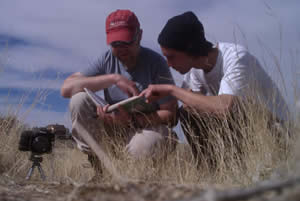
Kenneth & Jackson |
| Dr. Ayesha Burdett, Tom Turner Lab: Ayesha's research has focused on how invertebrate community structure differs over time and among different habitats, particularly in systems with variable flow regimes. She is interested in the interplay between biotic and abiotic controls on the dynamics of community and trophic structure. |
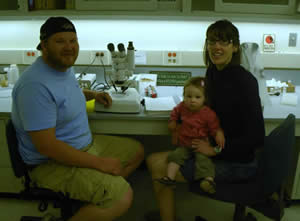
Ayesha & Matt |
| Tyler Pilger, Tom Turner Lab: Tyler's research interests are applying population genetics to community ecology and conservation of species. HeI received a M.S. degree at Kansas State University where he studied the food web of native and nonnative fishes in the Gila River drainage of New Mexico. For his dissertation research he is focusing on comparative population genetics of these same fish species, whose differing life-history strategies might affect their metapopulation dynamics. |
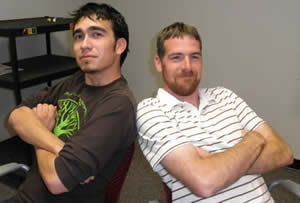
Tyler & Jesse |
| Justine Hall, Cristina Takacs-Vesbach Lab |
|
| Christian Gunning, Helen Wearing Lab: Christian is currently studying infectious disease dynamics in the United States in the early 20th century. He uses a mixture of mechanistic mathematical models, statistical detective work, data visualization, and population and community ecological theory to explain observed patterns of disease invasion, persistence, and competition in bothspace and time. After leaving UNM, he plans to use his quantitative skills to continue research into nonlinear dynamical systems in biology. |
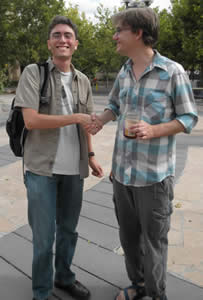
Christian & Nathan |
| Natalie Wright, Chris Witt Lab: Natalie is broadly interested in evolutionary and ecological patterns in birds. Her dissertation work focuses on how the flight muscles of birds evolve in response different ecological pressures, such as how flight muscles differ along an elevational gradient, between island and mainland populations, and among birds with different flight styles. She plans to pursue a career in biological research, teaching, and mentoring. |
|
| Theresa Hyde, Blair Wolf Lab, UnO Program Coordinator: Theresa is Hopi Indian and was the Graduate Student Coordinator for the UnO Program from its inception until May 2010, when she graduated with an MS in biology. She is now working as a biological monitor in Nevada for the desert tortoise. |
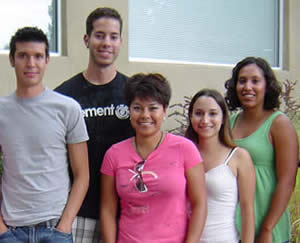
Theresa (center) with several scholars |
